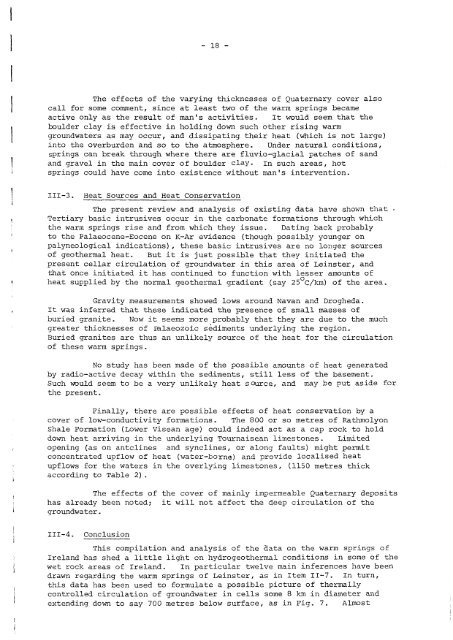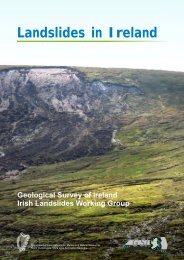- 17 -The effects <strong>of</strong> heat on the circulation <strong>of</strong> groundwater can be verystrik<strong>in</strong>g, <strong>in</strong> particular when considered from the hydrogeological viewpo<strong>in</strong>t.By rais<strong>in</strong>g temperatures <strong>of</strong> groundwater, its viscosity will be decreased, sothat its transmissibility will be <strong>in</strong>creased. Thus, rais<strong>in</strong>g temperaturesfrom lOoe to 20 0 e will <strong>in</strong>crease flow by over 30%, all other conditionsrema<strong>in</strong><strong>in</strong>g the same. Heat<strong>in</strong>g also decreases the density <strong>of</strong> the warmedgroundwater, and such density differences re<strong>in</strong>force gravity-controlled flows.As such thermal flow cont<strong>in</strong>ues, much more heat will be brought up <strong>in</strong> thewater by convection than by the earlier conduction <strong>in</strong> the rock and/orstatic water. Ris<strong>in</strong>g temperatures can <strong>in</strong>duce thermal shatter<strong>in</strong>g <strong>of</strong> therock, and <strong>in</strong>crease permeability. While such flow mechanisms areconsidered here for bas<strong>in</strong>s <strong>of</strong> say 8 kilometres diameter, they have beenstudied on a cont<strong>in</strong>ental scale by one <strong>of</strong> the authors <strong>in</strong> the great artesianbas<strong>in</strong>s <strong>of</strong> North Africa and Arabia (Burdon, 1978).The depths to which groundwater circulation might extend can be<strong>in</strong>ferred accord<strong>in</strong>g to the assumed geothermal gradient and the amount <strong>of</strong>mix<strong>in</strong>g. Accept<strong>in</strong>g a geothermal gradient <strong>of</strong> 25 0 e/kilometer, and an <strong>in</strong>creaseo 0 0<strong>of</strong> water temperature <strong>of</strong> 15 e (from 10 e to 25 e), then the depth <strong>of</strong>circulation below surface would be <strong>of</strong> the order <strong>of</strong> 600 metres with nomix<strong>in</strong>g. If there is much admixture <strong>of</strong> cooler (and shallower) groundwaterto the ris<strong>in</strong>g warm water, then the depth <strong>of</strong> circulation could be much greater.The fact that spr<strong>in</strong>g water temperatures rise as flow <strong>in</strong>creases canbeexpla<strong>in</strong>ed <strong>in</strong> a number <strong>of</strong> ways. strong thermal upflows may push aside otherwaters and result <strong>in</strong> less mix<strong>in</strong>g. The greater the volume <strong>of</strong> upflow, themore heat is brought up, so that water temperatures tend to rise.The hydrochemistry does not shed too much light on the problem.The geology <strong>in</strong>dicates that evaporite deposits occur and are to be expected<strong>in</strong> the shelf limestones, as <strong>in</strong> the Upper Tournaisian. Sulphate nodulesand lenses have been reported, but it would seem that halite was notprecipitated. High chlor<strong>in</strong>e and total dissolved solids characterisethree spr<strong>in</strong>gs (No. 1001, Lousia Bridge; No. 1004, st. Patrick's well;and No. 1009, St. Margarets) ly<strong>in</strong>g on a NE to SW l<strong>in</strong>e and possibly along theaxis <strong>of</strong> a syncl<strong>in</strong>e <strong>in</strong> the Lower Visean. There would be reason forbeliev<strong>in</strong>g that these spr<strong>in</strong>gs obta<strong>in</strong> their more-then-average m<strong>in</strong>eralisedgroundwaters from deeper beds with some evaporites. The other spr<strong>in</strong>gshave chlor<strong>in</strong>e which can <strong>in</strong> part be due to cyclic chlor<strong>in</strong>e <strong>in</strong> theprecipitation, though as already noted NOS. 1005 and 1006 also arecomparatively high <strong>in</strong> chlor<strong>in</strong>e. While there are no apparent directcorrelationships between temperatures and hydrochemistry, the latter supportsthe idea that the groundwater circulation is sufficiently deep <strong>in</strong> at leastone group <strong>of</strong> warm spr<strong>in</strong>gs to have gone down to the evaporite beds thoughtto exist <strong>in</strong> the Upper Tournaisian.There is little <strong>in</strong>formation as to the formation conditions which~uuld allow groundwater to circulate freely down to depths <strong>of</strong> the order <strong>of</strong>700 metres. The Hercynian fold<strong>in</strong>g <strong>of</strong> the rocks must have opened up flowpaths on anticl<strong>in</strong>es and syncl<strong>in</strong>es. The geological location <strong>of</strong> several<strong>of</strong> the warm spr<strong>in</strong>gs would suggest connections with anticl<strong>in</strong>al or syncl<strong>in</strong>alaxes. The extent and depth <strong>of</strong> Quaternary karstification <strong>in</strong> <strong>Ireland</strong> isstill very uncerta<strong>in</strong>; but karstification below say 100 metres from surfaceis not very likely, controlled as it should be by low sea levels dur<strong>in</strong>gand soon after the glacials. However, if evaporite beds, as gypsum,anhydrite and halite, form appreciable sequences <strong>in</strong> the general carbonatesuccession, then their solution <strong>in</strong> circulat<strong>in</strong>g groundwater (not controlledby the availability <strong>of</strong> free carbon dioxide <strong>in</strong> the water), could result <strong>in</strong>deep karstification.
- 18 -The effects <strong>of</strong> the vary<strong>in</strong>g thicknesses <strong>of</strong> Quaternary cover alsocall for some comment, s<strong>in</strong>ce at least two <strong>of</strong> the warm spr<strong>in</strong>gs becameactive only as the result <strong>of</strong> man's activities. It would seem that theboulder clay is effective <strong>in</strong> hold<strong>in</strong>g down such other ris<strong>in</strong>g warmgroundwaters as may occur, and dissipat<strong>in</strong>g their heat (which is not large)<strong>in</strong>to the overburden and so to the atmosphere. Under natural conditions,spr<strong>in</strong>gs can break through where there are fluvio-glacial patches <strong>of</strong> sandand gravel <strong>in</strong> the ma<strong>in</strong> cover <strong>of</strong> boulder clay. In such areas, hotspr<strong>in</strong>gs could have come <strong>in</strong>to existence without man's <strong>in</strong>tervention.111-3. Heat Sources and Heat ConservationThe present review and analysis <strong>of</strong> exist<strong>in</strong>g data have shown thatTertiary basic <strong>in</strong>trusives occur <strong>in</strong> the carbonate formations through whichthe warm spr<strong>in</strong>gs rise and from which they issue. Dat<strong>in</strong>g back probablyto the Palaeocene-Eocene on K-Ar evidence (though possibly younger onpalyneological <strong>in</strong>dications), these basic <strong>in</strong>trusives are no longer sources<strong>of</strong> geothermal heat. But it is just possible that they <strong>in</strong>itiated thepresent cellar circulation <strong>of</strong> groundwater <strong>in</strong> this area <strong>of</strong> Le<strong>in</strong>ster, andthat once <strong>in</strong>itiated it has cont<strong>in</strong>ued to function with lesser amounts <strong>of</strong>heat supplied by the normal geothermal gradient (say 2S o C/km) <strong>of</strong> the area.Gravity measurements showed lows around Navan and Drogheda.It was <strong>in</strong>ferred that these <strong>in</strong>dicated the presence <strong>of</strong> small masses <strong>of</strong>buried granite. Now it seems more probably that they are due to the muchgreater thicknesses <strong>of</strong> Balaeozoic sediments underly<strong>in</strong>g the region.Buried granites are thus an unlikely source <strong>of</strong> the heat for the circulation<strong>of</strong> these warm spr<strong>in</strong>gs.No study has been made <strong>of</strong> the possible amounts <strong>of</strong> heat generatedby radio-active decay with<strong>in</strong> the sediments, still less <strong>of</strong> the basement.Such would seem to be a very unlikely heat source, and may be put aside forthe present.F<strong>in</strong>ally, there are possible effects <strong>of</strong> heat conservation by acover <strong>of</strong> low-conductivity formations. The 800 or so metres <strong>of</strong> RathmolyonShale Formation (Lower Visean age) could <strong>in</strong>deed act as a cap rock to holddown heat arriv<strong>in</strong>g <strong>in</strong> the underly<strong>in</strong>g Tournaisean limestones. Limitedopen<strong>in</strong>g (as on antcl<strong>in</strong>es and syncl<strong>in</strong>es, or along faults) might permitconcentrated upflow <strong>of</strong> heat (water-bo'rne) and provide localised heatupflows for the waters <strong>in</strong> the overly<strong>in</strong>g limestones, (1150 metres thickaccord<strong>in</strong>g to Table 2) .The effects <strong>of</strong> the cover <strong>of</strong> ma<strong>in</strong>ly impermeable Quaternary depositshas already been noted; it will not affect the deep circulation <strong>of</strong> thegroundwater.111-4. ConclusionThis compilation and analysis <strong>of</strong> the Jata on the warm spr<strong>in</strong>gs <strong>of</strong><strong>Ireland</strong> has shed a little light on hydrogeothermal conditions <strong>in</strong> some <strong>of</strong> thewet rock areas <strong>of</strong> <strong>Ireland</strong>. In particular twelve ma<strong>in</strong> <strong>in</strong>ferences have beendrawn regard<strong>in</strong>g the warm spr<strong>in</strong>gs <strong>of</strong> Le<strong>in</strong>ster, as <strong>in</strong> Item 11-7. In turn,this data has been used to formulate a possible picture <strong>of</strong> thermallycontrolled circulation <strong>of</strong> groundwater <strong>in</strong> cells some B kID <strong>in</strong> diameter andextend<strong>in</strong>g down to say 700 metres below surface, as <strong>in</strong> Fig. 7. Almost
















